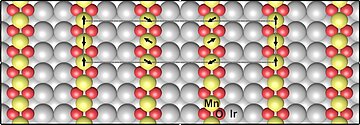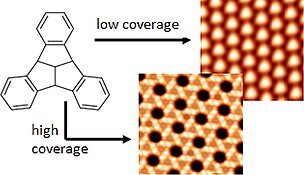2019
Image & Results Gallery (2019 archive)
Discovery of indirectly coupled chiral magnetism
June 13, 2019
It has been known for a long time that electron spins can couple magnetically via the so-called Ruderman-Kittel-Kasuya-Yosida (RKKY) interaction even if their wave functions lack any overlap. This coupling is usually collinear, i.e., the magnetic moments are pointing either in the same or opposite directions. Theoretical proposals predicted that spin-orbit scattering could also lead to a chiral indirect exchange interaction, giving rise to spiral-shaped spin structures. However, no practical realization has yet been known. In a recent research project performed jointly with colleagues from Trieste (Italy), Thuwal (Saudi Arabia), and the FZ Jülich (Germany) we discovered that MnO2 grown on the noble metal iridium are antiferromagnetically ordered along the chains but exhibit chiral magnetic oder with a 120° rotation between adjacent MnO2 chains. Density functional theory calculations confirm that this order is indeed caused by the long searched for indirect spin-orbit induced chiral echange interaction. The result has been published in Nature Communications.
Molecular growth and charge transfer on surfaces
March 9, 2019
The structure of organic compounds on metal surfaces is of great interest for the fabrication of devices in the field of organic electronics but for future progress a deeper understanding of intermolecular interactions and charge transfer is required. In cooperation with the research group of Prof. Anke Krüger at Würzburg's Institute for Organic Chemistry we have investigated the two-dimensional self-assembly of tribenzotriquinacenes (TBTQs) on Ag(111) by scanning tunneling microscopy (STM). Highly ordered monolayers were observed for the first time. STM measurements identify a charge transfer between substrate and TBTQ. The result has been published in the Journal of Physical Chemistry C.







